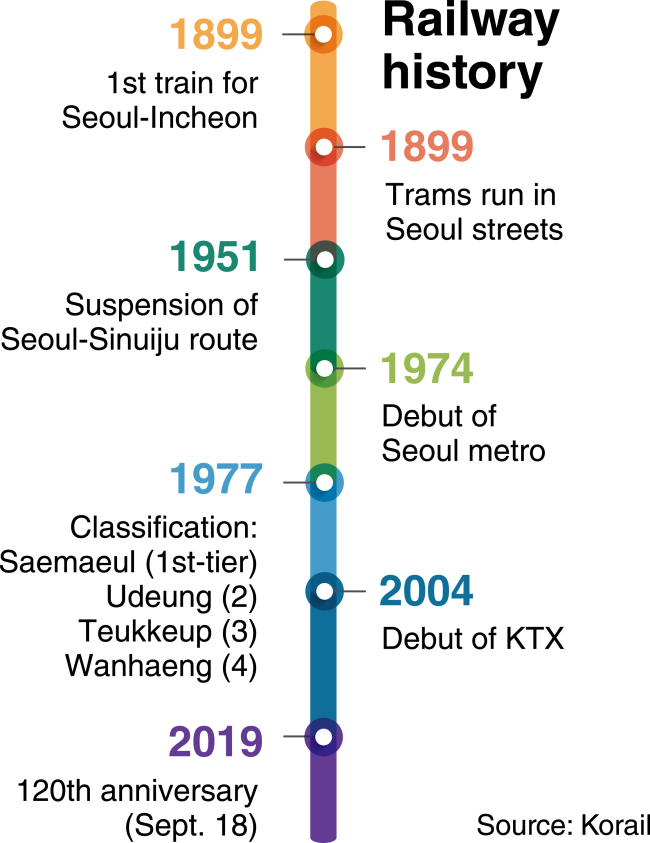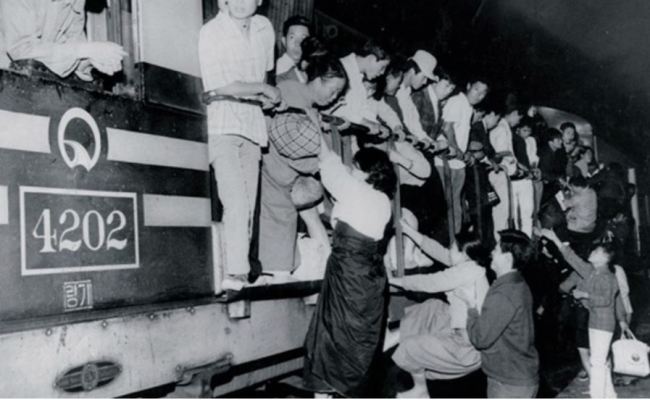[News Focus] Trains run for 120 years - from Noryangjin to KTX era
By Kim Yon-sePublished : April 28, 2019 - 16:37
SEJONG -- In the 1970s and ’80s, a dominant portion of Seoulites took trains to visit their hometowns spread across the country during the two biggest holidays of each year to celebrate Lunar New Year’s Day and Chuseok.
Those days were before the “my car era” opened in Korea in the early 1990s.
As tickets for the Saemaeul and Mugunghwa (also dubbed train udeung) were relatively expensive, the third-tier Tongil (train teukkeup) and fourth-tier Bidulgi (train botong or wanhaeng) gained more popularity among ordinary households.
In case of the Seoul-Janghang line for the western part of the nation, it took about five hours for those riding on Bidulgi in Seoul to reach Daecheon Station in South Chungcheong Province, as the lowest-tier train stopped at all big and small stations and traveled at a low maximum speed.
Those days were before the “my car era” opened in Korea in the early 1990s.
As tickets for the Saemaeul and Mugunghwa (also dubbed train udeung) were relatively expensive, the third-tier Tongil (train teukkeup) and fourth-tier Bidulgi (train botong or wanhaeng) gained more popularity among ordinary households.
In case of the Seoul-Janghang line for the western part of the nation, it took about five hours for those riding on Bidulgi in Seoul to reach Daecheon Station in South Chungcheong Province, as the lowest-tier train stopped at all big and small stations and traveled at a low maximum speed.

Delayed arrivals were common and coaches were frequently crowded, as a number of standing tickets were recklessly issued aside from all occupied seats during the holidays.
In the early 1990s, a growing portion of people began using automobiles to arrive in Daecheon-dong in the city of Boryeong, which was Daecheon-eup, Boryeong-gun in the early 1980s. The region is currently located a two-hour driveway from Seoul.
Despite long hours to destinations, travels by train were romantic experiences for college students of the day. They visited Muchangpo Beach in Ungcheon, South Chungcheong Province, and its neighboring Daecheon Beach with acoustic guitars. These days the two beaches are even well-known to foreign visitors.
The Korea Railroad Corp. terminated the operations of the Bidulgi and Tongil trains, in turn, in the early 2000s. Instead, Korean Train Express, better known as KTX, finally tapped the market in April 2004.
“The KTX era could be likened to a renaissance in the nation’s railroad history,” said an official of the Land, Infrastructure and Transport. “It has contributed much to dispersing saturated demand for expressways and national highways.”
According to Korail, the average number of KTX passengers is 180,000 a day, up 150 percent from 15 years ago.
The high-speed train enables Seoulites to make round trips to Osong Station, a location near the Sejong self-governing city, in about 100 minutes, while it takes about four hours for a Seoul-Sejong round-trip drive when traffic is light.
The government embarked on the construction of the Gyeongbu High Speed Railway for KTX in 1992. Though its initial completion target was 1998, the 1997 Asian currency crisis hampered and delayed the project.
At present, KTX lines nationwide are Gyeongbu, Honam, Jeolla, Gyeongjeon, Donghae and Gangneung.
In 2010, the government unveiled a plan to reduce travel times from Seoul to 95 percent of the country to under two hours by 2020.
The main new element of the plan is to aim for top speeds of 250 kilometers per hour in upgrades of much of the mainline network with a view to the introduction of KTX services.
While the “bullet train” stops at 48 stations in 15 cities or provincial locations across the nation, some raise the necessity of building more stations in rapidly growing cities like Sejong.
This year Korea marks the 120th anniversary of its railroad history since the railway linking Noryangjin Station in Seoul and Jemulpo Station in Incheon for a 33.2-kilometer distance went into operation on Sept. 18, 1899.
While an opening ceremony to operate the steam locomotive was held at Noryangjin Station at that time, there is an allegation that Japan -- which bought the rights of the Gyeongin Line construction from an American -- initiated the railroad project in an attempt to plunder resources and workforce.

The Seoul-Incheon route regardless marked the “first” railroad alongside the nation’s first (Gyeongin) expressway, set up in 1968 and linking Sinwol-dong, Seoul and Gajeong-dong, Incheon.
In the late 1980s, the combined length of the country’s railroad network was about 6,300 kilometers, including 760 kilometers of double-track railroad and 1,020 kilometers of electrified railroad. Suburban lines were electrified and connected to the Seoul subway system, while rolling stock included about 450 diesel locomotives, 90 electric locomotives, 133 motor coaches and 370 electric motor cars as of 1987.
Meanwhile, the operation of the Gyeongui Line linking Seoul and Sinuiju in North Korea has been halted for 68 years since June 1951.
While the trams running the centers of Seoul streets also operated between 1899 and 1968, the current metro history started in 1974 in Seoul, where subway lines Nos. 1 to 9 have been created over the past four decades.
A huge number of commuters to Seoul, residing in satellite cities such as Euijeongbu, Goyang, Bucheon, Gwancheon and Seongnam, are using the rapid transit system.
By Kim Yon-se (kys@heraldcorp.com)











![[Today’s K-pop] BTS pop-up event to come to Seoul](http://res.heraldm.com/phpwas/restmb_idxmake.php?idx=644&simg=/content/image/2024/04/17/20240417050734_0.jpg&u=)




![[KH Explains] Hyundai's full hybrid edge to pay off amid slow transition to pure EVs](http://res.heraldm.com/phpwas/restmb_idxmake.php?idx=652&simg=/content/image/2024/04/18/20240418050645_0.jpg&u=20240418181020)

![[Today’s K-pop] Zico drops snippet of collaboration with Jennie](http://res.heraldm.com/phpwas/restmb_idxmake.php?idx=642&simg=/content/image/2024/04/18/20240418050702_0.jpg&u=)